|

WiMAX systems
The growing interest for broadband mobile has boosted major investments and research efforts in the development of broadband wireless access (BWA) networks. Despite these efforts, there is still a gap between rural and urban areas in the development and application of Information Communication Technologies (ICTs). Wired technologies like ADSL or cable have failed to provide fixed access in rural areas, where the revenues from serving few scattered customers do not compensate for the great investments in network infrastructure. On the other hand, fixed wireless solutions have been proposed as a viable and cost effective solution to serve spread populated areas, with WiMAX emerging as a strong candidate due to its operation under Non Line Of Sight (NLOS) conditions. In this context, Uwicore worked during 2006 and 2007, in the framework of a national R&D project called Rural-Tur, on the development of a WiMAX platform for the provision of multimedia services for rural tourism. In particular, Uwicore implemented a WiMAX system planning tool and a WiMAX link level emulator.
WiMAX system planning
Considering the difficult geographic conditions encountered in rural areas, the dimensioning of a WiMAX system in rural areas requires the use of planning tools with extensive Geographic Information System (GIS) databases. While some commercial planning software is generally available, Uwicore completely developed a new tool, focused on rural environments, to provide small local operators with a cost-efficient valuable tool to support their fixed wireless rural deployments.
The Uwicore WiMAX system platform, named WiGIPLAN (Wireless GIS-Assisted Planning), has been completely developed in MATLAB. The current WiGIPLAN version allows the user to dimension a fixed-wireless WiMAX network in order to ensure that coverage and capacity levels are guaranteed according to the system requirements. Uwicore intends, preferably together with industrial partners, to further exploite the computational capabilities of MATLAB by incorporating in WiGIPLAN automatic base station deployment algorithms based on propagation, capacity and economic factors.
The following figure shows a plot of the WiGIPLAN planning tool considering a WiMAX deployment for a rural area in the north of Spain. Apart from Digital Elevation Model (DEM), WiGIPLAN also employs cartography and terrain usage information. These geodatabases can be very useful for the planning process since they can provide information on the suitability and cost of a given Base Station (BS) location site. The terrain usage data, extracted from the CORINE Land Cover 2000 Project, is also used in WiGIPLAN to classify terrain and calculate pathloss under heterogeneous terrain types. For a WiMAX radio deployment, the user can select the BS locations, use different vendor equipments, and modify the BS transmitting parameters.
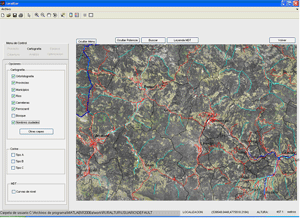
To calculate the receive signal levels, the tool implements the following five models for PTP and for PMP deployments: Stanford University Interim model (SUI) recommended by the IEEE 802.16 standardisation group, a SUI heterogeneous model implemented by Uwicore and making extensive use of the WiGiPLAN GIS database, Okumura-Hata model, COST 231-Hata model and the diffraction-based ITU-R P.525 model. An example propagation coverage plot for a three BS deployment is shown below; the received signal levels can be shown in various graphic formats.
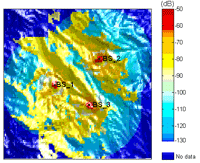
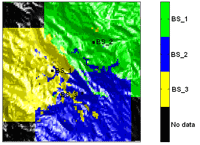
Using the received signal level estimates and possible modulation schemes, WiGiPLAN can also provide indications on the achievable transmission speeds at various geographic locations. This information is aimed at assisting an operator on its BS deployments following the geographic conditions and user QoS requirements.
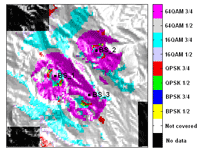
WiMAX link level platform
In addition to the WiGIPLAN planning tool, Uwicore has also implemented a link level WiMAX simulation platform as shown in the figure below. This emulator allows to analyse the link level simulation performance of WiMAX systems under various channel quality conditions, dominated by either channel noise or multipath fading. The intention is to extend this platform to incorporate source coding modules to directly test a particular service's user-perceived QoS level under various link level conditions.
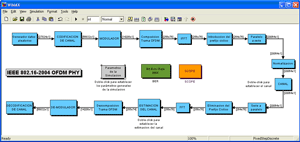

|